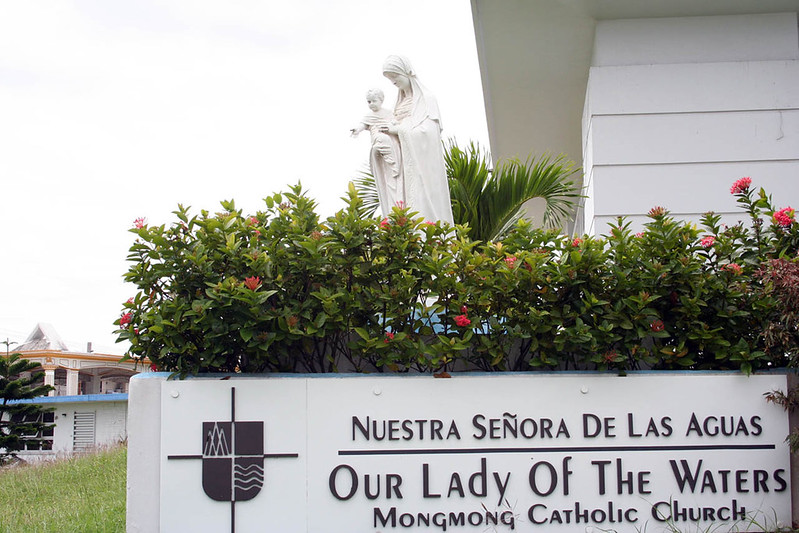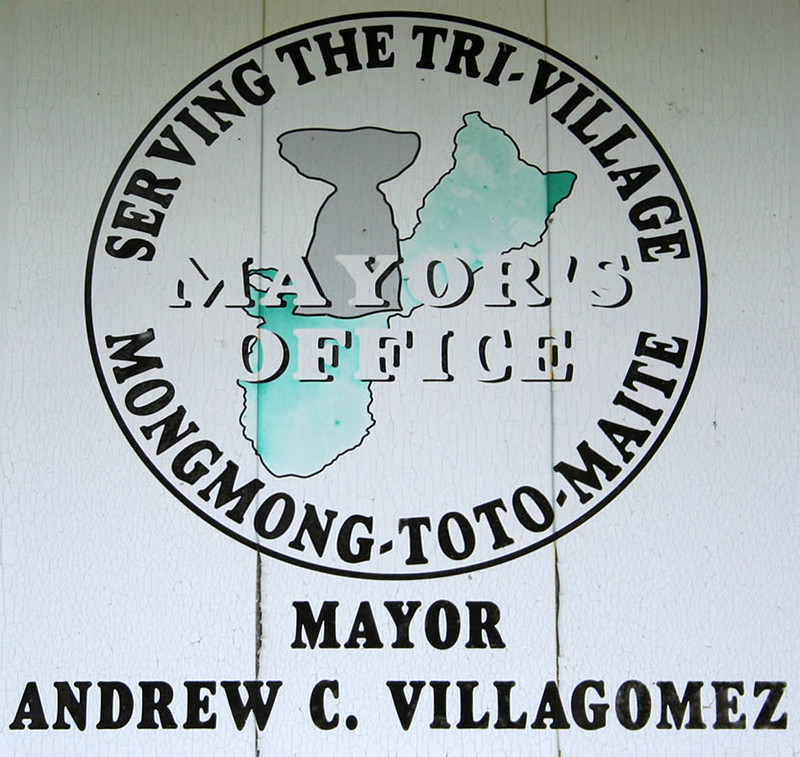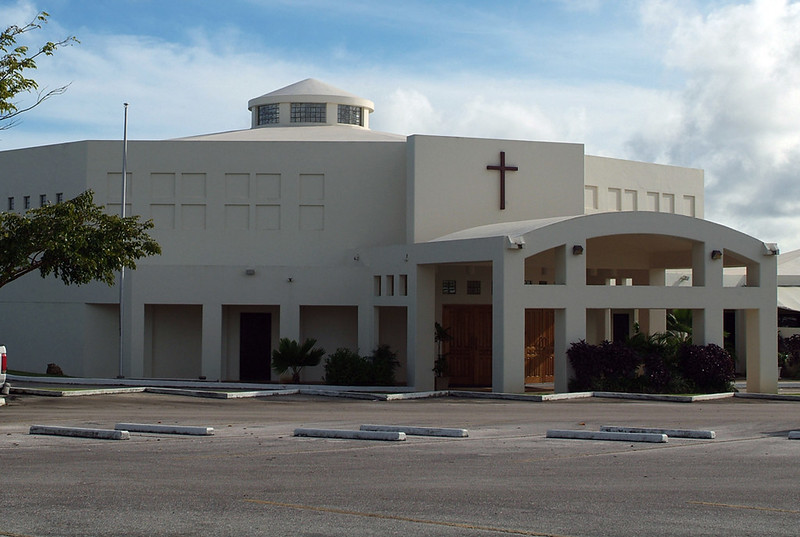Mongmong-Toto-Maite (Mongmong-To’to-Maite’)
Origin of village name in CHamoru
The three villages of Mongmong, Toto, and Maite comprise one municipality.
There are various theories about how the villages got their names. They are said to relate to the Legend of Puntan and Fu’una, the CHamoru creation myth of the world. When the god Puntan was about to die, he and his sister the goddess Fu’una devised a plan that would use his body to form the world and the elements of the sky: his eyes were to become the sun and the moon, his body to become the earth.
Momongmong, later to become Mongmong, describes the sound of a heartbeat. Toto means to recline. Maite, or ma’ette, means to nudge or touch another person with one’s hands or other parts of the body.
Mongmong also may refer to another sound. Before World War II, nubenas (a devotion of nine days of prayer) were held in the village to pray for rain during the dry season. People would walk from Hagåtña and had to step over potholes in the trail made by cattle during the rainy season. The dirt ridges of the holes would crumble as they walked, making a sound called mongmong in CHamoru.
Toto may also have gotten its name from a fight between two ancient district warriors. The loser was left lying on the ground face up, which is called to’to (to recline).
Population
According to the 2010 US Census, the total population of Mongmong-Toto-Maite is 6,825.
Village officials
Rudy A. Paco is the mayor of Mongmong-Toto-Maite.
Village description
Mongmong-Toto-Maite is located in central Guam, just north of the capital city of Hagåtña. Aside from the airplanes flying directly over the tri-village before landing in the neighboring area of Tiyan, many residents of Mongmong-Toto-Maite find it to be a very quiet and peaceful place to live. Maite’s cliffline, with beautiful sunset views, is home to some of the island’s most well-known families, including the Calvos, whose attractive homes line the cliff above east Hagåtña.
Mongmong and Toto for the most part are rural, residential areas. Mongmong runs parallel to Maite and is at the center of the tri-village. It is heavily vegetated and is the most populated of the three villages. Toto borders Barrigada to the north of the other two villages, and is known for its winding roads and swamplands.
However, there is also a busy industrial side to the Mongmong-Toto-Maite. The area of Maite and Toto along Route 8 between Tiyan and the island’s capital, Hagåtña is primarily an industrial area, filled with warehouses, hardware and furniture stores, mom-and-pop markets, and many popular bargain shops.
Mongmong’s Catholic Church is Nuestra Senora de Las Aguas (Our Lady of the Waters). Parishioners celebrate their annual fiesta in honor of their patron saint on the last Saturday of January.
The Immaculate Heart of Mary Church in Toto celebrates its patron saint’s fiesta in June each year.
The village of Maite does not have a Catholic Church and does not have a village fiesta. The Bayview Baptist Church and Son of God Baptist Church are located in Maite.
Village history
Sixty years ago, Mongmong-Toto-Maite was not a place to live; it was a place to work. And working at that time didn’t mean reporting to an eight-hour job in an office. It meant walking a few miles to a ranch to farm for food, as was typical for many areas of Guam.
Before the Japanese occupation of Guam in 1941, Mongmong-Toto-Maite was mainly used for small-scale farming and raising poultry and other livestock. Most of the people who used the land prior to the war lived in Hagåtña and would walk through jungle trails to the tri-village to farm in the morning and return home in the evening.
Mongmong was particularly popular during the early months of the year when people from all over the island would travel there to honor the village’s patron saint Nuestra Senora de Las Aguas, or Our Lady of the Waters. They would pray to her for rain during the island’s dry season. In 1881, a man named James Young wrote to his sister in Australia telling her about the residents’ devotion to the saint. He said people believed that this image of the Virgin Mary appeared to some villagers during a strong typhoon in 1850, and caused a perfect calm that saved their farm from destruction.
In 1898, only seven families lived in the area. Others simply owned ranches there. But this quickly changed during World War II. While the Japanese Imperial Army populated Hagåtña, several families began migrating to the Mongmong-Toto area. And even more families moved there after the heavy US bombardment followed by an invasion of troops on the island, which eventually ended the Japanese occupation.
As Hagåtña became a business area, Mongmong-Toto-Maite was one of the villages that housed the families who used to live in the capital. At this time, Mongmong and Toto also accommodated the Fifth Service Depot, a US Marine supply outlet, pushing residents to the hilly, rugged and swampy areas of the tri-village. It became a popular place to live because residents felt safe being so close to the Marines right after a war. And many villagers found jobs at the depot. Several Quonset huts were built in Mongmong and used for schools, such as the original George Washington High School.
The three villages were officially combined when the Organic Act, which granted residents of Guam US citizenship, became effective sometime in 1951. The tri-village was made a single entity to help expedite ballot polling during elections and other administrative procedures.
By Victoria-Lola Leon Guerrero, MFA
Points of interest
Village map
Institutions
Mongmong
Nuestra Senora de Las Aguas (Our Lady of the Waters) Catholic Church
The Nuestra Senora de Las Aguas (Our Lady of the Waters) Church was established 11 July 1969. During the patron saint’s feast day, the village’s Catholic parishioners make their way through the small streets of the village during an annual procession.
Toto
Immaculate Heart of Mary Catholic Church
The Immaculate Heart of Mary Church was initially a chapel located in the center of the village sometime in the mid-1940s. It was first a tent structure, erected on the property of the late Tun Ignacio Martinez. After a typhoon destroyed the structure, the chapel was relocated to a thatched roof building at the entrance of the village belonging to the Borja family. Father Julius Sullivan, OFM, Cap., was assigned to the chapel and responsible for having a permanent structure erected and dedicated in 1948.
Juan Q. San Miguel Elementary School
Commonly referred to as JQ San Miguel Elementary, it is one of the elementary schools of the Guam Public School System. It was constructed in 1971 and later named in honor of San Miguel who owned a retail store in Mongmong and was also a civic and political leader.
Harvest Christian Academy (K3-12th Grade)
Harvest Ministries has been established on Guam for more than 30 years, and its campus sits on more than twelve acres of land for elementary through high school students.
Village mayors/commissioners
Mayors/Commissioners
- Rudy Paco, Mayor, 2017-Present
- Andrew C. Villagomez, Mayor, 1997-2016
- Antonio D. Materne, Commissioner/Mayor, 1989-1997
- Jesus C. Bamba, Commissioner, 1985-1989
- Rodney J. Villagomez, Commissioner, 1981-1985
- Norberto F. Ungacta, Commissioner, 1977-1981
- Jose E. Santos, Commissioner, 1973-1977
- Jose C. Farfan, Commissioner, 1961-1973
- Jesus M. Camacho, Commissioner, 1952-1961
- Jose C. Duenas, Commissioner, 1945-1952
- Manuel Q. San Miguel, Commissioner, 1944
| Editor’s note: | The preceding list was provided by Konsehelon Mahot Guåhan/the Mayor’s Council of Guam. |
|---|
For further reading
Guam Harvest Christian Academy. “Helping Students Develop a Heart for God.”
Guam’s Parks and Historic Places. An Interpretive Companion. Hagåtña: GDPR, 1993.
Mayors Council of Guam. “MCOG – Mayors Council of Guam.”
Onedera, Peter R., ed. Nå’an Lugåt Siha gi ya Guåhan (Guam Place Names). Hagåtña: Chamorro Language Commission, 1988.
Palomo, Tony. An Island in Agony. Self-published, 1984.
Rogers, Robert. Destiny’s Landfall: A History of Guam. Honolulu: University of Hawai`i Press, 1995.















